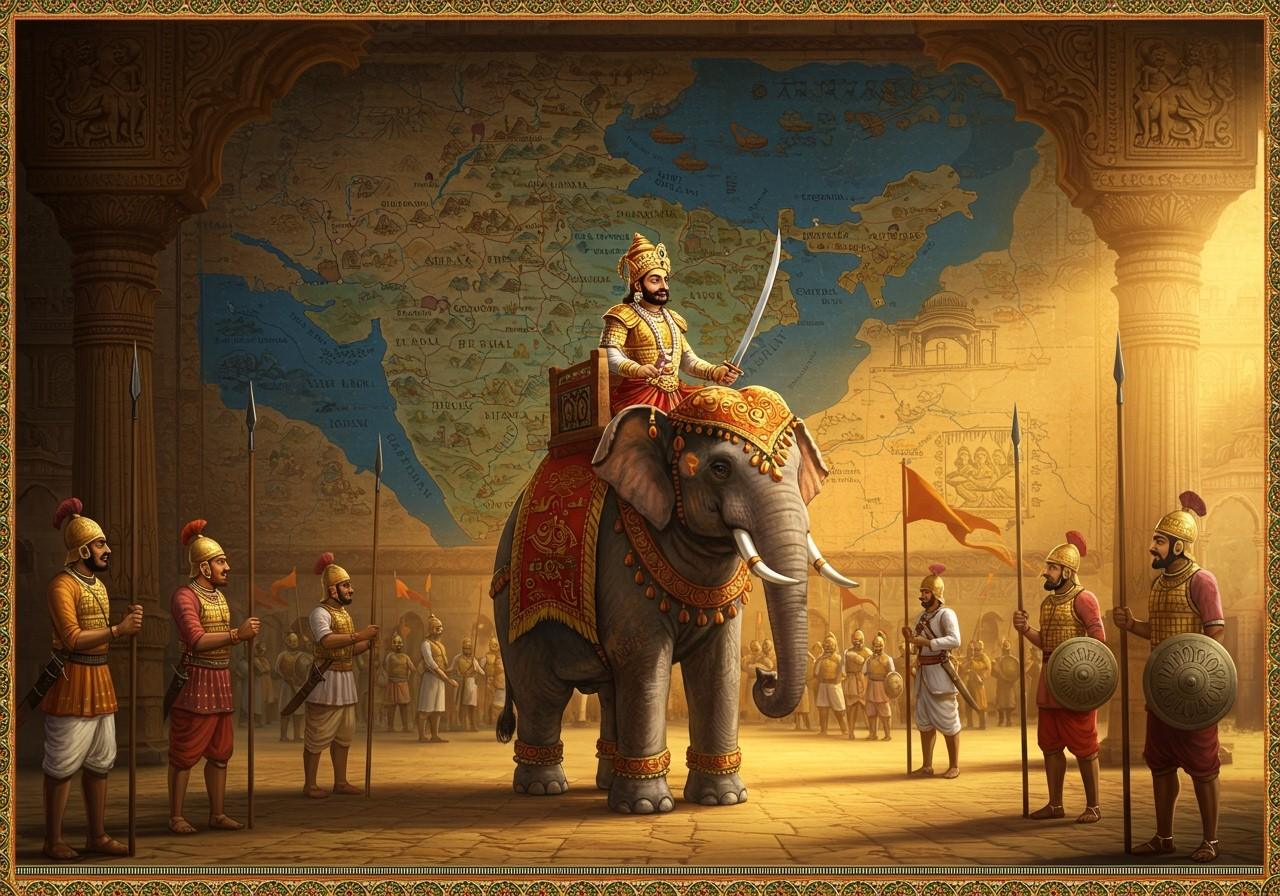
The Gupta Dynasty, a pivotal era in Indian history (3rd-6th century CE), is often hailed as India’s Golden Age. This period witnessed remarkable territorial expansion, cultural flourishing, and economic prosperity, leaving an enduring legacy on the nation’s heritage. Exploring the territorial reach and expansion strategies of the Gupta Empire provides valuable insights into India’s historical and cultural evolution.
The Rise of the Guptas
The Gupta Dynasty emerged in the early 4th century CE under the leadership of Chandragupta I. His strategic marriage into the influential Lichchhavi family solidified his power and legitimacy, initially establishing his reign in the Magadha region. The Guptas played a significant role in the resurgence of Hindu culture and traditions.
Samudragupta, Chandragupta I’s successor, and later Chandragupta II, further expanded the empire’s boundaries through military prowess and diplomatic alliances. Effective administrative strategies ensured the empire’s control over its vast territories.
Samudragupta’s Conquests (4th Century CE)
Samudragupta, often called the “Napoleon of India,” spearheaded significant territorial expansions. His military campaigns brought regions like present-day Uttar Pradesh, Bihar, Bengal, and Punjab under Gupta rule. The Allahabad Pillar inscription provides a detailed account of these conquests. These expansions dramatically altered India’s political landscape, integrating newly acquired regions into the Gupta Empire both culturally and economically.
The Golden Zenith Under Chandragupta II (4th-5th Century CE)
The Gupta Empire reached its peak during the reign of Chandragupta II. Territories like Gujarat and parts of Western India were annexed through strategic conquests and alliances, including a significant marriage alliance with the Vakataka dynasty. This era marked a period of immense prosperity and a cultural renaissance, with advancements in art, literature, and science. Ujjain flourished as a major cultural and economic hub due to efficient administration and stability.
Gupta Administration and Economy (3rd-6th Century CE)
The Gupta Empire boasted a decentralized yet highly effective administrative system. The empire was divided into provinces known as Bhuktis, governed by appointed officials. Local administration and village councils played a vital role in maintaining order and implementing imperial policies.
A network of flourishing trade routes and robust agricultural productivity fueled the empire’s economic growth. Its strategic location on key trade routes further bolstered its wealth and facilitated prosperity across diverse regions.
Decline and Lasting Legacy (5th-6th Century CE)
Despite its golden age, the Gupta Dynasty eventually declined due to a combination of internal strife and external pressures. Invasions by the Huns and internal political instability weakened the empire, leading to its fragmentation into smaller kingdoms. However, the Guptas left an indelible mark on India’s cultural, political, and economic landscape. Their contributions to art, literature, science, and governance continued to influence generations to come.
Poojn.in: Connecting to India’s Spiritual Heritage
At Poojn.in, we offer a curated collection of authentic puja items and religious artifacts that connect you with India’s rich spiritual heritage, including traditions from the Gupta period (3rd-6th century CE). Our offerings include:
- Brass and copper items inspired by Gupta-era metalwork, allowing you to bring home a piece of history.
- Traditional incense and dhoop based on ancient recipes, creating an ambiance reminiscent of ancient rituals.
- Sacred texts and religious literature to deepen your understanding of Hindu traditions and philosophies.
- Authentic ritual items used in traditional Hindu ceremonies, enabling you to practice these time-honored rituals.
We are committed to making these ancient traditions accessible to you through:
- Detailed product descriptions explaining the cultural significance of each item, enriching your spiritual practice.
- Pan-India delivery, ensuring that you can access these sacred items regardless of your location.
- Guaranteed quality and authenticity of all religious products, preserving the integrity of your spiritual practice.
- User-friendly website and mobile app for convenient shopping, making it easy for you to connect with your heritage.
Visit Poojn.in or download our mobile app to explore our complete collection and discover how you can enrich your spiritual journey.
Lord Shiva Murti
Mangalam Camphor
Conclusion
The Gupta Dynasty’s expansion and territorial control profoundly shaped India’s cultural, political, and economic landscape. From its inception under Chandragupta I to its zenith under Chandragupta II, the dynasty’s effective governance and strategic alliances fostered a golden age of advancements in various fields. Though it eventually met decline, the Gupta Empire’s legacy continues to resonate within India’s rich traditions and heritage. Understanding this historical period offers a deeper appreciation for the Gupta Dynasty’s profound impact on India’s development.
FAQs
Where was the Gupta Dynasty located? The Gupta Dynasty was primarily located in northern India, centered around present-day Uttar Pradesh and Bihar.
What was the extent of the Gupta Empire? The Gupta Empire encompassed a large portion of northern India, including present-day Uttar Pradesh, Bihar, Madhya Pradesh, and parts of Bengal.
How did the Gupta Dynasty expand its territory? The Gupta Dynasty expanded through military conquests, strategic marriages, and diplomatic alliances with other kingdoms.
What is the significance of the Gupta Dynasty map? Maps of the Gupta Empire visually depict its vast territorial extent at its peak, illustrating the dynasty’s significant political influence.
Why is the Gupta Dynasty considered a golden age? The Gupta era is considered a golden age due to remarkable advancements in art, literature, science, and architecture, coupled with a period of relative peace and economic prosperity.
Which cities were prominent during Gupta rule? Important cities during the Gupta period included Pataliputra (the capital), Ujjain, and Mathura, each playing significant roles in the empire’s administration, culture, and economy.
What cultural achievements marked the Gupta period? The Gupta period witnessed significant cultural achievements, including the flourishing of classical Sanskrit literature, advancements in mathematics and astronomy, and remarkable artistic and architectural developments.
Did the Gupta Dynasty’s influence extend beyond its borders? Yes, the Gupta Dynasty exerted influence on other regions through trade networks, cultural exchange, and the spread of Buddhism and Hinduism.


